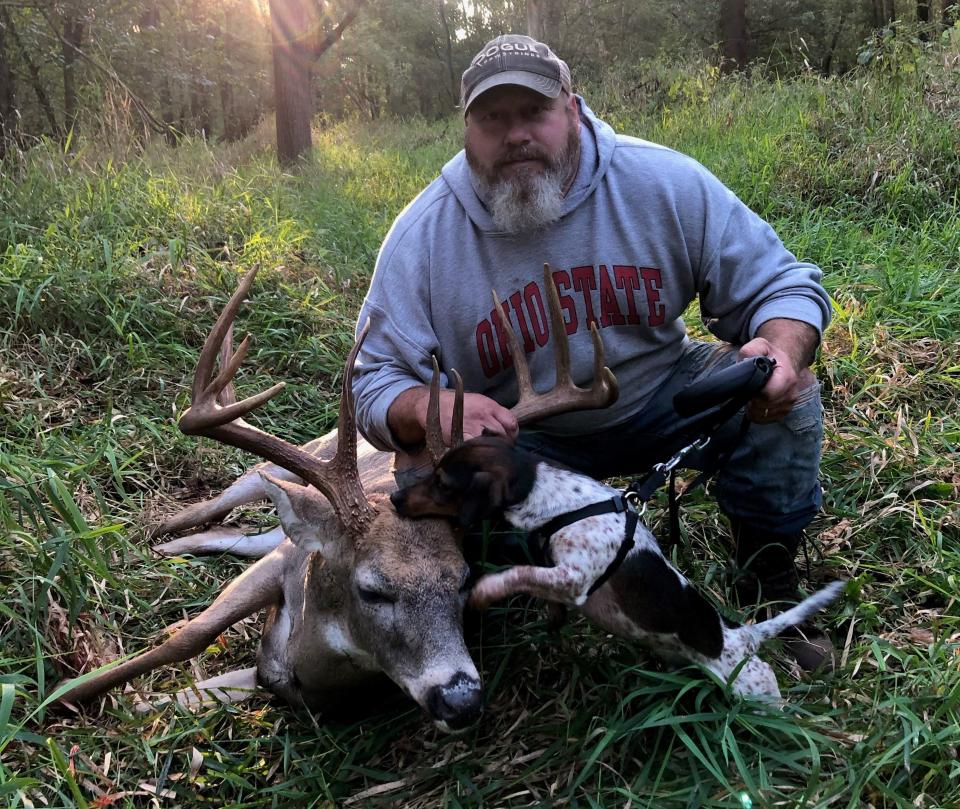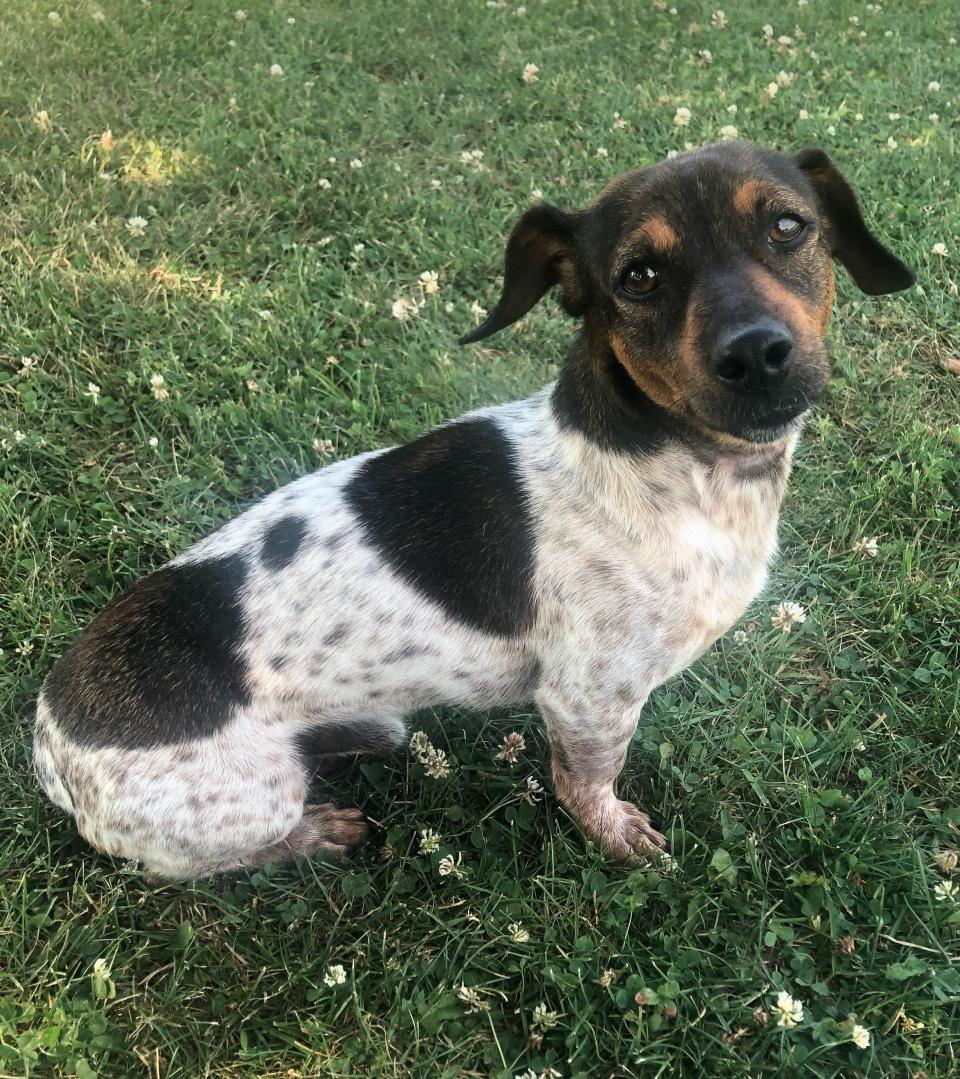Small but effective: Jack's got a nose for tracking deer

WALHONDING - If you would ask the average person to envision the perfect dog to track deer, Jack would not come to mind. But when it comes to results, Jack is about as good as it gets.
Jack is a Jack Russell/Dachshund (wiener dog) mix, and is owned by Brian Yoder. The two combine one of their favorite pastimes, deer hunting and recovering those shot deer. In fact, Jack is so good at what he does, he even has his own Facebook page (Jack's Deer Recovery Service).
"People say why don't you have a lab or a blood hound, and I tell them I don't want a big dog pulling me over logs and through briars," Yoder said.
And while most hunting dogs do their thing off the leash, it's a law that if you're tracking deer, your dog has to be on a lead or a leash. It is legal to track deer in 36 states.
PATIENCE PAYS OFF: Female bowhunter from Nashville arrows 15-point buck in Wayne County
Their noses are in the strike zone
That's one of the advantages of having the small Jack Russell-Dachshund cross breed, as well as they are so low to the ground that their noses are always in the strike zone.
"You can use any dog, but if you truly want to get into this, I'd suggest getting a smaller breed," said Yoder.
Jack is 2 1/2 years old, and this is his second year of tracking. Last year he recovered 18 of the 26 tracks he went on, and the ones he and Yoder didn't find, almost all weren't dead and ran away.
This year, Jack already has been busy.
In the first week of bow season, Jack found a big buck that scored close to 200, starting 12 hours after the hunter shot it.
"The first Saturday of the deer season this year I had six calls, and one Saturday during the rut last year I had 13 voicemails to go track deer," said Yoder.
"I don't like to take Jack on more than one track a day, unless it's a short one. He does get tired. If you over-run him, he does lose interest. I try to limit how many tracks I run him on."
HUNTING THE WHITETAIL: It's all about smiles, memories: Whitetail Heritage youth hunt is for all the right reasons
Fun and playful all year, until deer season when Jack gets down to business
And while Jack most of the year is a normal dog, playing with Yoder's daughters and going on walks, once deer season rolls around, he's all business.
"All I have to do is say, 'hey Jack, wanna go find a deer?,' and he totally knows what we're doing. He goes and runs to the truck and jumps up into the back seat," Yoder said.
Yoder got Jack from Eddie Schlabach, who has a famous tracking dog of his own, Porky.
"Eddie had this pup named Jack and he asked me if I'd be interested in it," said Yoder. "He said he didn't have time to work with it, and I said, 'absolutely.' That was in July of 2019."
Schlabach told Yoder to only take Jack on live tracks, so Yoder let everyone in his neighborhood know he was training Jack to track deer, and if they shot a deer, even if they knew where it was, to let him know so Jack could get experience. Needless to say, Jack was a natural from the start.
Well, almost all the time.

'Jack, we're not here for mice'
"One time we were on a track and Jack takes a hard left and comes back with a dead mouse in his mouth," remembered Yoder. "I said, 'Jack, we're not here for mice.'"
In fact, while a dead scent is something tracking dogs key into, when it comes to finding shot deer, it's the scent emitted by the interdigital gland that is the key to tracking.
"When a deer is wounded, it gives off a separate scent," said Yoder. "A wounded deer puts out a totally different scent than any other deer in the woods."
Before Yoder and Jack go on a track, Yoder asks the hunter some important questions.
"Have you tracked it at all," said Yoder of his first question. "Then I ask, 'where did you hit it?' and 'have you found any hair or blood?' Then I go out that night or the next day depending on the information."
Yoder says the longest he likes to wait before going on a track is 24 hours.
"As a handler, if you don't trust your dog, you might as well not get out of your truck," said Yoder. "You have to trust him and let him do his job. ... It's amazing to watch Jack track a deer."
Yoder charges $50 to come out and start the process, and asks for another $150 if Jacks finds the deer."
Depending on the deer, that may seem like a drop in the bucket, or a price too high. But then again, Yoder is leaving home, at times at 11 p.m. at night, and pushing through briars and brush as Jack does his thing.
"Money has nothing to do with it," said Yoder. "The reward is the recovered deer and seeing the smile on the hunter's face."
To learn more about Yoder and his dog, visit Jack's Facebook page: Jacks Deer Recovery Service.
Outdoor correspondent Art Holden can be reached at letsplabal@yahoo.com.
This article originally appeared on The Daily Record: Little Jack Russell about as good as it can get at tracking deer

